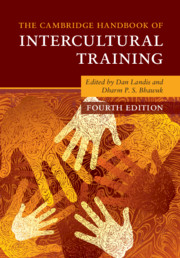Book contents
- The Cambridge Handbook of Intercultural Training
- Reviews
- The Cambridge Handbook of Intercultural Training
- Copyright page
- Dedication
- Frontispiece
- Contents
- Figures
- Tables
- Editors and Contributors
- Foreword
- Preface
- 1 Introduction and Theoretical Framework
- Part I Theoretical Foundations of Intercultural Training
- Part II Practice of Intercultural Training
- Part III Indigenous Psychology and Intercultural Training
- 15 Brazilian Cultural Patterns and Intercultural Training
- 16 Russian Cultural Patterns and Intercultural Training
- 17 Indian Psychology and Intercultural Training
- 18 Culture-Inclusive Theories for Intercultural Training in Confucian Societies
- 19 Japanese Psychology and Intercultural Training
- Part IV New Interdisciplinary Approaches to Intercultural Training
- Part V Summing Up
- Index
- References
16 - Russian Cultural Patterns and Intercultural Training
from Part III - Indigenous Psychology and Intercultural Training
Published online by Cambridge University Press: 18 September 2020
- The Cambridge Handbook of Intercultural Training
- Reviews
- The Cambridge Handbook of Intercultural Training
- Copyright page
- Dedication
- Frontispiece
- Contents
- Figures
- Tables
- Editors and Contributors
- Foreword
- Preface
- 1 Introduction and Theoretical Framework
- Part I Theoretical Foundations of Intercultural Training
- Part II Practice of Intercultural Training
- Part III Indigenous Psychology and Intercultural Training
- 15 Brazilian Cultural Patterns and Intercultural Training
- 16 Russian Cultural Patterns and Intercultural Training
- 17 Indian Psychology and Intercultural Training
- 18 Culture-Inclusive Theories for Intercultural Training in Confucian Societies
- 19 Japanese Psychology and Intercultural Training
- Part IV New Interdisciplinary Approaches to Intercultural Training
- Part V Summing Up
- Index
- References
Summary
Russia is often described as a complex, unpredictable, and distinct culture that poses substantial challenges for sojourners. Many sojourners perceive Russian nationals as both hard-working and lethargic, approachable and inaccessible, or trusting and distrusting. These contrasts and complexities make it challenging for sojourners to adjust and function effectively. This paper provides some resources for cross-cultural training professionals working with sojourners going to Russia by shedding light on some important aspects of the Russian culture. We discuss the culture-general and culture-specific aspects relevant for sojourners in Russia and discuss how culture-general theories can explain some of the specific aspects of the Russian culture. We discuss implications for cross-cultural trainers preparing sojourners for Russia and provide recommendations for training design.
- Type
- Chapter
- Information
- The Cambridge Handbook of Intercultural Training , pp. 523 - 539Publisher: Cambridge University PressPrint publication year: 2020



